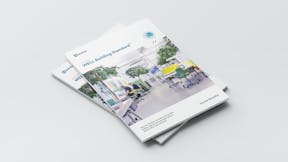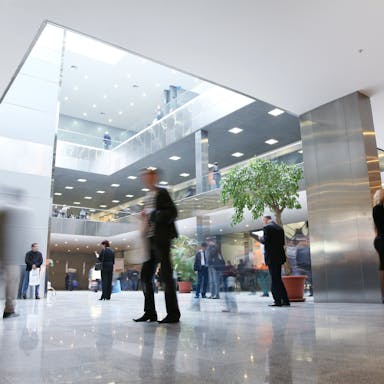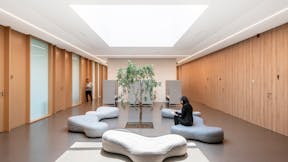Can you tell us about the WELL AP qualification?
The design and construction sector has made big strides in making buildings more sustainable by adhering to certain environmental rating systems such as LEED and BREEAM. But within those frameworks, there’s only a small section focused on human health.
A lot of research has recently been done about how buildings impact on human health and the WELL rating system has been created to fill this gap. It complements the environmental rating systems and provides a wider approach to wellbeing and allows architects and designers to give more focus to building occupants within their project.
COVID has turbo-charged the concept of wellbeing; wellbeing and sustainability are going to be key priorities in the A&D world in the coming years.
Tell us a bit more about the exam? What concepts were covered that you found particularly useful for suspended ceiling projects?
The accreditation is an examination process that examines seven different concepts: air, light, comfort, mind, water, nourishment and fitness. Air, light, comfort and mind were the main concepts relevant to suspended ceilings.
Air – this focused on air quality and practices such as reducing VOCs (volatile organic compounds) within the spaces that are occupied. In other words, making sure we’re not putting harmful substances into the building. Suspended ceilings can assist in this area due to the low emission standards they can adhere to such as M1 Emission Class for Building Material.
Light – this focused on light quality and glare. Making sure we’re getting the right amount of light into the room by using the various surfaces, such as ceilings with an LRV of 80% or greater, to get us to the point where we’re comfortable and not interrupting the circadian rhythm unnecessarily. Suspended ceilings can be used to achieve great results here whilst also reducing energy costs by helping to reduce the amount of artificial lighting required in a space
Comfort – this concept was particularly relevant to us here at Rockfon. As ceiling manufacturers, we tend to focus on acoustics and this generally falls within the comfort concept which looks at internally generated noise, acoustic planning, reverberation times, sound masking, sound-reducing surfaces and all areas to do with sound management in space.
Mind – this concept is aimed at improving occupants mental health by making the occupants feel welcome in the spaces. Acoustic ceilings can help gain preconditions and optimisations in the mind feature by helping to create calm peaceful spaces and aiding privacy. The mind is also focused on bringing the outside in, making us better connected with nature. An example of how this can be done is by using islands shaped like outside leaves to bring in cues around nature within the spaces. Acoustics is one aspect covered in the post-occupancy surveys required for this particular feature.
Was the study genuinely interesting and relevant?
It was, yes. They really dived into how these features apply to the way the building is designed. So for me, with a keen interest in well being and sustainability, it was a logical next step for me to bring these insights to the specifiers I work with. It gave specific information and advice about the preconditions that need to be satisfied in order to gain WELL certification on a building. Plus it went into various optimisations that can be incorporated to allow you to step up from silver to gold or platinum accreditation.
What else did you find useful about the program?
I like how it gave me a broad understanding of the building environment. It also reinforced the fact that acoustics ceilings (and wall panels) do so much more. It is also clear that WELL is growing in importance as there are 685 million square feet of space either certified or waiting to be certified.
If anyone has any questions, how can they reach you?
You can either find my details on the Specification Team page, or add me on LinkedIn.

Get WELL Certified
Rockfon solutions contribute to 8 out of 10 WELL concepts. Enhancing everything from the acoustic atmosphere to lighting conditions and aesthetics.








